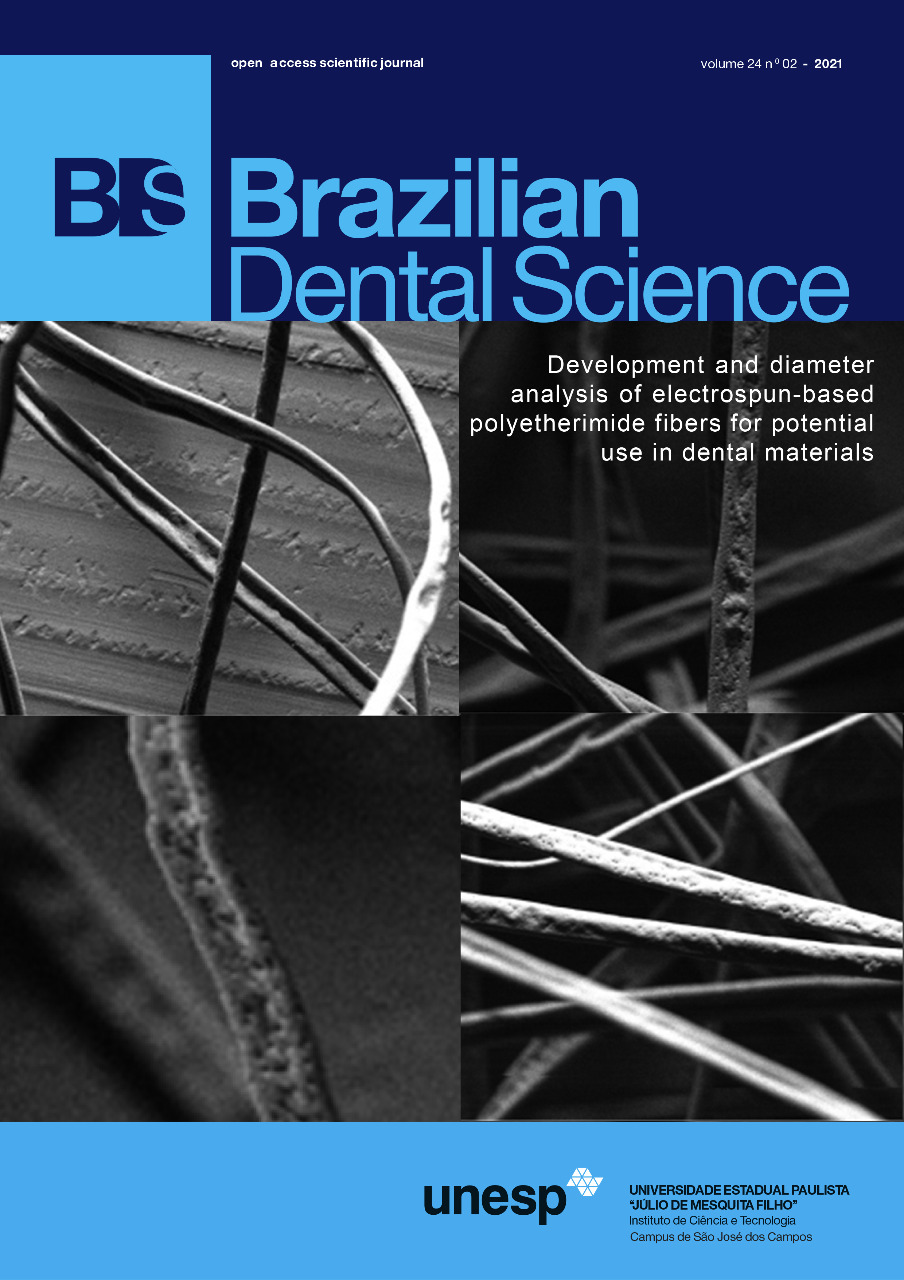In-vitro efficacy of two spectrophotometer-based shade matching systems for color matching of ceramics after artificial accelerated aging
DOI:
https://doi.org/10.14295/bds.2021.v24i2.2317Abstract
Objective: The objective of the present invitro study was to verify the efficacy of two spectrophotometer-based shade matching systems for color matching of ceramics after artificial accelerated aging (AAA). Material and Methods: : The ceramics used were porcelain laminated veneers. Seventy standard-shaped discs (thickness x diameter: 0.5 mm x 10 mm) of B1 shades were used. Based upon the type of resin cement used, the specimens were divided into seven groups (10/group). The following light-cured cements were used: RelyX-Veneer (L-RV), Variolink-Veneer (L-VV), and VariolinkEsthetic (L-VE). The dual-cured cements were: RelyX Ultimate (D-RU), RelyX-Unicem (D-RC), and Variolink-Esthetics DC (D-VE). The control group consisted of ceramic only. All specimens were thermocycled in water for 3,500 cycles between 5 o C -55 o C, with dwell times of 30 s in each bath and a transfer time of 10 s between baths. All specimens were thermocycled in water for 3,500 cycles between 5 o C and 55 o C, and color measurement was done using the VITA Easyshade and ColorEye spectrophotometers. Baseline color reading was performed 24-hours after cementation. Differences in color (DE) of EasyShade and ColorEye before and after AAA were determined and compared statistically. Group comparisons were done using the paired t-tests. Level of significance was set at P< 0.05. Results: The mean differences in color (DE) values obtained from EasyShade spectrophotometer for light- and dual-cured cements, were 0.843±0.89 (Lc1), 4.11±0.69 (Lc2) and 0.833±0.47 (Lc3); and 2.22±0.64 (Dc1), 3.37±0.83 (Dc2) and 0.38±0.92 (Dc3), respectively. The mean differences in color (DE) values obtained from ColorEye spectrophotometer for light- and dual-cured cements, were 0.68±0.86 (Lc1), 4.55±0.83 (Lc2) and 2.68±0.26 (Lc3); and 2.06±0.84 (Dc1), 1.8±1.08 (Dc2) and 0.96±0.71 (Dc3), respectively. There was no significant difference in the mean DE values among the groups. Conclusion: The VITA Easyshade and ColorEye shade matching systems are comparable in terms of their efficacy for color matching of cerammics after AAA.
Keywords
Artificial accelerated aging; Color matching; In vitro; Porcelain veneer; Spectrophotometer.
Downloads
References
REFERENCES
AlGhazali N, Burnside G, Smith RW, Preston AJ, Jarad FD. Performance assessment of Vita Easy Shade spectrophotometer on colour measurement of aesthetic dental materials. Eur J Prosthodont Restor Dent. 2011;19(4):168-174.
Seghi RR, Johnston WM, O'Brien WJ. Performance assessment of colorimetric devices on dental porcelains. J Dent Res. 1989;68(12):1755-1759.
Paul SJ, Peter A, Rodoni L, Pietrobon N. Conventional visual vs spectrophotometric shade taking for porcelain-fused-to-metal crowns: a clinical comparison. Int J Periodontics Restorative Dent. 2004;24(3):222-231.
Da Silva JD, Park SE, Weber HP, Ishikawa-Nagai S. Clinical performance of a newly developed spectrophotometric system on tooth color reproduction. J Prosthet Dent. 2008;99(5):361-368.
Baltzer A, Kaufmann-Jinoian V. Shading of ceramic crowns using digital tooth shade matching devices. Int J Comput Dent. 2005;8(2):129-152.
Olms C, Setz JM. The repeatability of digital shade measurement--a clinical study. Clin Oral Investig. 2013;17(4):1161-1166.
Fazi G, Vichi A, Corciolani G, Ferrari M. Spectrophotometric evaluation of color match to VITA classical shade guide of four different veneering porcelain systems for metal ceramic restorations. Am J Dent. 2009;22(1):19-22.
Shono NN, Al Nahedh HN. Contrast ratio and masking ability of three ceramic veneering materials. Oper Dent. 2012;37(4):406-416.
Mayekar SM. Shades of a color. Illusion or reality? Dent Clin North Am. 2001;45(1):155-172, vii.
Werling G. Veneers--treatment of Class V defects using the Cerec method. Int J Comput Dent. 2007;10(2):187-194.
Sadowsky SJ. An overview of treatment considerations for esthetic restorations: a review of the literature. J Prosthet Dent. 2006;96(6):433-442.
Perroni AP, Bergoli CD, Dos Santos MBF, Moraes RR, Boscato N. Spectrophotometric analysis of clinical factors related to the color of ceramic restorations: A pilot study. J Prosthet Dent. 2017;118(5):611-616.
Pimental W, Tiossi R. Comparison between visual and instrumental methods for natural tooth shade matching. Gen Dent. 2014;62(6):47-49.
Wang P, Wei J, Li Q, Wang Y. Evaluation of an optimized shade guide made from porcelain powder mixtures. J Prosthet Dent. 2014;112(6):1553-1558.
Yilmaz B, Karaagaclioglu L. In vitro evaluation of color replication of metal ceramic specimens using visual and instrumental color determinations. J Prosthet Dent. 2011;105(1):21-27.
Czigola A, Abram E, Kovacs ZI, Marton K, Hermann P, Borbely J. Effects of substrate, ceramic thickness, translucency, and cement shade on the color of CAD/CAM lithium-disilicate crowns. J Esthet Restor Dent. 2019.
Karaokutan I, Yilmaz Savas T, Aykent F, Ozdere E. Color Stability of CAD/CAM Fabricated Inlays after Accelerated Artificial Aging. J Prosthodont. 2016;25(6):472-477.
Alqahtani FI. Effect of newly Developed Resin Cements and Thermocycling on the Strength of Porcelain Laminate Veneers. J Contemp Dent Pract. 2017;18(3):209-213.
Barbon FJ, Moraes RR, Boscato N, Alessandretti R, Spazzin AO. Feldspar Ceramic Strength and The Reinforcing Effect by Adhesive Cementation Under Accelerated Aging. Braz Dent J. 2018;29(2):202-207.
Kvam K, Karlsson S. Solubility and strength of zirconia-based dental materials after artificial aging. J Prosthet Dent. 2013;110(4):281-287.
Pires-de-Souza Fde C, Casemiro LA, Garcia Lda F, Cruvinel DR. Color stability of dental ceramics submitted to artificial accelerated aging after repeated firings. J Prosthet Dent. 2009;101(1):13-18.
Kurt M, Turhan Bal B. Effects of accelerated artificial aging on the translucency and color stability of monolithic ceramics with different surface treatments. J Prosthet Dent. 2019;121(4):712.e711-712.e718.
Downloads
Published
How to Cite
Issue
Section
License
Brazilian Dental Science uses the Creative Commons (CC-BY 4.0) license, thus preserving the integrity of articles in an open access environment. The journal allows the author to retain publishing rights without restrictions.
=================




























